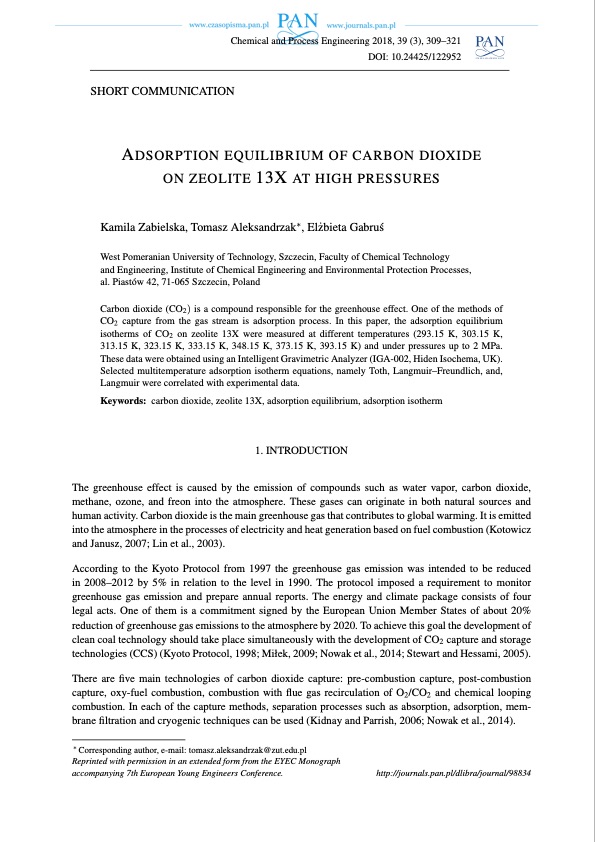
PDF Publication Title:
Text from PDF Page: 001
Chemical and Process Engineering 2018, 39 (3), 309–321 DOI: 10.24425/122952 SHORT COMMUNICATION ADSORPTION EQUILIBRIUM OF CARBON DIOXIDE ON ZEOLITE 13X AT HIGH PRESSURES Kamila Zabielska, Tomasz Aleksandrzak∗, Elz ̇bieta Gabrus ́ West Pomeranian University of Technology, Szczecin, Faculty of Chemical Technology and Engineering, Institute of Chemical Engineering and Environmental Protection Processes, al. Piastów 42, 71-065 Szczecin, Poland Carbon dioxide (CO2) is a compound responsible for the greenhouse effect. One of the methods of CO2 capture from the gas stream is adsorption process. In this paper, the adsorption equilibrium isotherms of CO2 on zeolite 13X were measured at different temperatures (293.15 K, 303.15 K, 313.15 K, 323.15 K, 333.15 K, 348.15 K, 373.15 K, 393.15 K) and under pressures up to 2 MPa. These data were obtained using an Intelligent Gravimetric Analyzer (IGA-002, Hiden Isochema, UK). Selected multitemperature adsorption isotherm equations, namely Toth, Langmuir–Freundlich, and, Langmuir were correlated with experimental data. Keywords: carbon dioxide, zeolite 13X, adsorption equilibrium, adsorption isotherm 1. INTRODUCTION The greenhouse effect is caused by the emission of compounds such as water vapor, carbon dioxide, methane, ozone, and freon into the atmosphere. These gases can originate in both natural sources and human activity. Carbon dioxide is the main greenhouse gas that contributes to global warming. It is emitted into the atmosphere in the processes of electricity and heat generation based on fuel combustion (Kotowicz and Janusz, 2007; Lin et al., 2003). According to the Kyoto Protocol from 1997 the greenhouse gas emission was intended to be reduced in 2008–2012 by 5% in relation to the level in 1990. The protocol imposed a requirement to monitor greenhouse gas emission and prepare annual reports. The energy and climate package consists of four legal acts. One of them is a commitment signed by the European Union Member States of about 20% reduction of greenhouse gas emissions to the atmosphere by 2020. To achieve this goal the development of clean coal technology should take place simultaneously with the development of CO2 capture and storage technologies (CCS) (Kyoto Protocol, 1998; Miłek, 2009; Nowak et al., 2014; Stewart and Hessami, 2005). There are five main technologies of carbon dioxide capture: pre-combustion capture, post-combustion capture, oxy-fuel combustion, combustion with flue gas recirculation of O2/CO2 and chemical looping combustion. In each of the capture methods, separation processes such as absorption, adsorption, mem- brane filtration and cryogenic techniques can be used (Kidnay and Parrish, 2006; Nowak et al., 2014). ∗ Corresponding author, e-mail: tomasz.aleksandrzak@zut.edu.pl Reprinted with permission in an extended form from the EYEC Monograph accompanying 7th European Young Engineers Conference. http://journals.pan.pl/dlibra/journal/98834PDF Image | ADSORPTION EQUILIBRIUM OF CARBON DIOXIDE ON ZEOLITE

PDF Search Title:
ADSORPTION EQUILIBRIUM OF CARBON DIOXIDE ON ZEOLITEOriginal File Name Searched:
Adsorption_equilibrium_of_carbon_di.pdfDIY PDF Search: Google It | Yahoo | Bing
CO2 Organic Rankine Cycle Experimenter Platform The supercritical CO2 phase change system is both a heat pump and organic rankine cycle which can be used for those purposes and as a supercritical extractor for advanced subcritical and supercritical extraction technology. Uses include producing nanoparticles, precious metal CO2 extraction, lithium battery recycling, and other applications... More Info
Heat Pumps CO2 ORC Heat Pump System Platform More Info
| CONTACT TEL: 608-238-6001 Email: greg@infinityturbine.com | RSS | AMP |